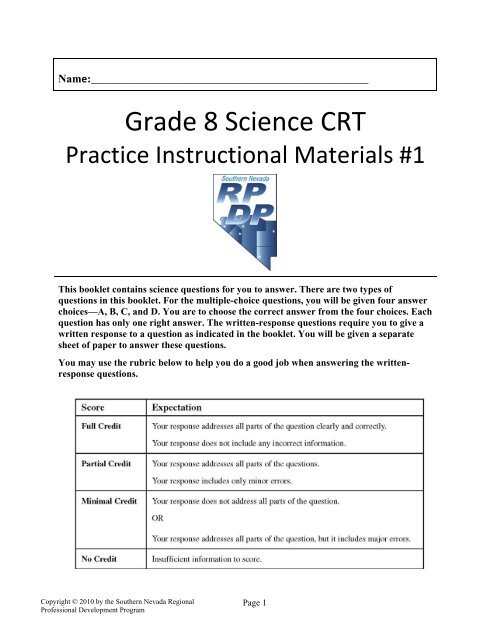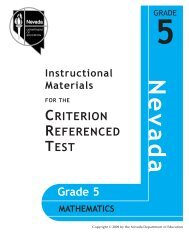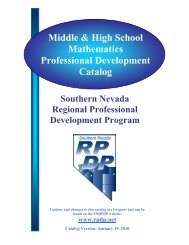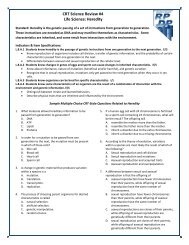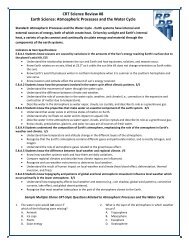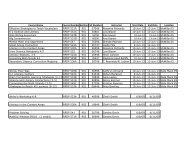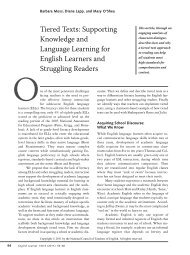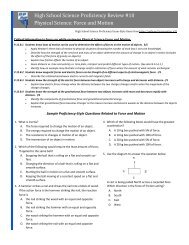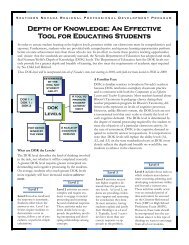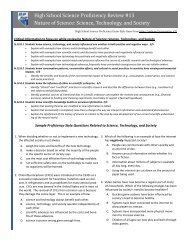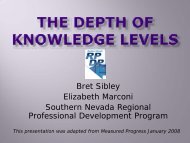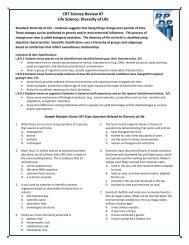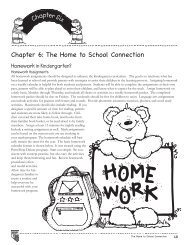Grade 8 Science CRT Instructional Material #1 - RPDP
Grade 8 Science CRT Instructional Material #1 - RPDP
Grade 8 Science CRT Instructional Material #1 - RPDP
Create successful ePaper yourself
Turn your PDF publications into a flip-book with our unique Google optimized e-Paper software.
Name:_________________________________________________<br />
<strong>Grade</strong> 8 <strong>Science</strong> <strong>CRT</strong><br />
Practice <strong>Instructional</strong> <strong>Material</strong>s <strong>#1</strong><br />
This booklet contains science questions for you to answer. There are two types of<br />
questions in this booklet. For the multiple-choice questions, you will be given four answer<br />
choices—A, B, C, and D. You are to choose the correct answer from the four choices. Each<br />
question has only one right answer. The written-response questions require you to give a<br />
written response to a question as indicated in the booklet. You will be given a separate<br />
sheet of paper to answer these questions.<br />
You may use the rubric below to help you do a good job when answering the writtenresponse<br />
questions.<br />
Copyright © 2010 by the Southern Nevada Regional<br />
Professional Development Program<br />
Page 1
<strong>Grade</strong> 8 <strong>Science</strong> <strong>CRT</strong> <strong>Instructional</strong> <strong>Material</strong>s <strong>#1</strong><br />
1<br />
What is the smallest unit of an element<br />
that still has the properties of that<br />
element?<br />
4<br />
Use the diagram to answer the<br />
following question. The diagram<br />
shows the water cycle.<br />
A A molecule<br />
B An electron<br />
C A compound<br />
D An atom<br />
2<br />
In rabbits, brown (B) fur is dominant to<br />
white (b) fur. If a rabbit with the genotype<br />
Bb is crossed with a rabbit with a genotype<br />
bb, what percentage of the offspring is<br />
expected to have brown fur?<br />
A 0%<br />
B 25%<br />
C 50%<br />
D 100%<br />
What change is occurring in stage 1<br />
of the diagram? Water is changing<br />
from a<br />
A liquid to a gas.<br />
B solid to a liquid.<br />
C gas to a liquid.<br />
D liquid to a solid.<br />
3<br />
Which of the following is the correct<br />
ranking of organizational hierarchy of<br />
organisms from simplest to most<br />
complex?<br />
A cells, organs, tissues, organ systems,<br />
organisms<br />
B cells, tissues, organs, organ systems,<br />
organisms<br />
C tissues, cells, organs, organ systems,<br />
organisms<br />
D tissues, organs, cells, organ systems,<br />
organisms<br />
5<br />
Fossils and sedimentary rocks form<br />
under specific conditions, so their<br />
presence in certain locations provides<br />
evidence for<br />
A past environments.<br />
B stationary continents.<br />
C constant temperatures.<br />
D magnetic pole reversal.<br />
Copyright © 2010 by the Southern Nevada Regional<br />
Professional Development Program<br />
Page 2<br />
Go On
<strong>Grade</strong> 8 <strong>Science</strong> <strong>CRT</strong> <strong>Instructional</strong> <strong>Material</strong>s <strong>#1</strong><br />
6<br />
Use the table below to answer the<br />
following question. The data table shows<br />
the number of deaths caused by influenza<br />
and pneumonia from 1917-1918, during<br />
the time of the 1918 influenza pandemic.<br />
8<br />
Use the diagram below representing<br />
different stages in succession to answer<br />
the following question.<br />
Select the order that represents how<br />
succession progresses in an ecosystem.<br />
A Diagram 1, 2, 3, 4<br />
B Diagram 2, 4, 1, 3<br />
C Diagram 4, 2, 1, 3<br />
D Diagram 3, 4, 2, 1<br />
7<br />
According to the data table, which age<br />
group shows the greatest increase in<br />
death rates caused by influenza and<br />
pneumonia from 1917 to 1918?<br />
A
<strong>Grade</strong> 8 <strong>Science</strong> <strong>CRT</strong> <strong>Instructional</strong> <strong>Material</strong>s <strong>#1</strong><br />
Write your answer to Question <strong>#1</strong>0 on a separate sheet of paper. Be sure to answer Parts A, B, and C<br />
10<br />
The diagram below shows two land masses separated by an ocean. Use the key to the right to<br />
aid in your written explanation.<br />
A scientist studying these two land masses hypothesizes that the land masses were once<br />
together.<br />
A Using the diagram, identify two pieces of evidence that support the scientist’s theory that<br />
the land masses were once together.<br />
B Explain how each piece of evidence you identified in Part A supports the scientist’s<br />
hypothesis.<br />
C Use your knowledge of plate tectonics to propose a reason why the land masses moved to<br />
their current position.<br />
Copyright © 2010 by the Southern Nevada Regional<br />
Professional Development Program<br />
Page 4<br />
Go On
<strong>Grade</strong> 8 <strong>Science</strong> <strong>CRT</strong> <strong>Instructional</strong> <strong>Material</strong>s <strong>#1</strong><br />
11<br />
Use the table below to answer the following question. The table shows characteristics of plant<br />
varieties.<br />
A farmer wants to grow a crop that is resistant to disease while producing more fruit per plant.<br />
Which plants should the farmer select to cross to get the desired combination of traits?<br />
A 1 and 2<br />
B 2 and 4<br />
C 1 and 3<br />
D 3 and 4<br />
12<br />
The diagram below shows a balance used to measure a burning candle in a sealed glass ball<br />
before and after the burning is complete.<br />
As the candle burns, the size of the candle decreases, but the reading on the balance does not<br />
change. Which of the following is demonstrated by this experiment?<br />
A Total mass of the system remains constant when the candle is burned.<br />
B Energy is converted to mass when the candle is burned.<br />
C Smoke particles have more mass than the molecules of candle wax.<br />
D Kinetic energy is converted to potential energy when the candle is burned.<br />
Copyright © 2010 by the Southern Nevada Regional<br />
Professional Development Program<br />
Page 5<br />
Go On
<strong>Grade</strong> 8 <strong>Science</strong> <strong>CRT</strong> <strong>Instructional</strong> <strong>Material</strong>s <strong>#1</strong><br />
13<br />
Use the diagram of the human body below to answer the following question.<br />
Which of the following describes the primary function of this system?<br />
A Supports the skeletal system<br />
B Absorbs nutrients from food<br />
C Responds to stimuli in the environment<br />
D Exchanges gases with the environment<br />
14<br />
Use the data table below to answer the following question.<br />
The majority of water on Earth exists as saltwater. Which water source would increase the<br />
most if ice caps and glaciers melt?<br />
A Oceans<br />
B Groundwater<br />
C Surface water<br />
D Atmosphere<br />
Copyright © 2010 by the Southern Nevada Regional<br />
Professional Development Program<br />
Page 6<br />
Go On
<strong>Grade</strong> 8 <strong>Science</strong> <strong>CRT</strong> <strong>Instructional</strong> <strong>Material</strong>s <strong>#1</strong><br />
15<br />
The diagram below represents a crosssection<br />
of several rock layers containing<br />
fossils.<br />
17<br />
Use the diagram below to answer the<br />
following question. The arrows below<br />
show forces acting on an object.<br />
16<br />
Which of the following layers of rock is<br />
most likely the youngest? The layer<br />
containing<br />
A dinosaurs.<br />
B amphibians.<br />
C fishes.<br />
D trilobites.<br />
Students were asked to measure a string.<br />
The actual length of the string was 8.25<br />
cm long. Which of the following shows<br />
the measurements from the most<br />
accurate group and why?<br />
A 7.25cm, 7.75cm, 8.25cm, because<br />
these were the closest to the actual<br />
length.<br />
B 7.2cm, 7.25cm, 7.3cm, because these<br />
had the most agreement between<br />
lengths.<br />
C 8.25cm, 8.75cm, 9.25cm, because<br />
these had the most agreement<br />
between lengths.<br />
D 8.2cm, 8.25cm, 8.9cm, because these<br />
were the closest to the actual length.<br />
18<br />
19<br />
What is the net force on the object and<br />
in what direction would the object<br />
move?<br />
A 100 N to the right<br />
B 100 N to the left<br />
C 100 N upward<br />
D 150 N upward<br />
Most of the minerals within an ecosystem<br />
are recycled and returned to the<br />
environment by the direct activities of<br />
organisms known as<br />
A producers.<br />
B consumers.<br />
C scavengers.<br />
D decomposers.<br />
In order for a lunar eclipse to occur, the<br />
moon must be in what phase?<br />
A Full Moon<br />
B First Quarter<br />
C Last Quarter<br />
D New Moon<br />
Copyright © 2010 by the Southern Nevada Regional<br />
Professional Development Program<br />
Page 7<br />
Go On
<strong>Grade</strong> 8 <strong>Science</strong> <strong>CRT</strong> <strong>Instructional</strong> <strong>Material</strong>s <strong>#1</strong><br />
20<br />
Use the diagram below to answer the following question.<br />
Which interval represents one full wavelength?<br />
A Point A to Point C<br />
B Point B to Point D<br />
C Point A to Point G<br />
D Point C to Point G<br />
21<br />
<strong>Science</strong>, technology, and society affect each other in both positive and negative ways. One<br />
example was the discovery of antibiotics. Which statement best describes the negative affect<br />
that antibiotics have had on society?<br />
A The extensive use of antibiotics has led to the evolution of resistant strains of bacteria.<br />
B The extensive use of antibiotics has caused several forms of new cancers to develop.<br />
C The use of antibiotics in consumer products has led to increased obesity in humans.<br />
D The increased use of antibiotics caused an over-abundance of medical professionals.<br />
22<br />
Scientists have discovered fossils of whale ancestors that have well developed hip and thigh<br />
bones, which are typically used for walking by mammals. Modern whales most likely evolved<br />
from ancestors who<br />
A lived in the sea, and then became better adapted for land.<br />
B lived on land, and then became better adapted for the sea.<br />
C evolved in the sea and remained in the sea.<br />
D evolved on land and remained on land.<br />
Copyright © 2010 by the Southern Nevada Regional<br />
Professional Development Program<br />
Page 8<br />
Go On
<strong>Grade</strong> 8 <strong>Science</strong> <strong>CRT</strong> <strong>Instructional</strong> <strong>Material</strong>s <strong>#1</strong><br />
23<br />
In order for a mutation to be passed from<br />
one generation to the next, the mutation<br />
must be present in which cell?<br />
25<br />
Which cell type in a human would<br />
most likely have the most<br />
mitochondria?<br />
A A muscle cell in the leg muscle of<br />
a runner.<br />
B A cell of the stomach lining that<br />
manufactures digestive enzymes.<br />
C A red blood cell that transports<br />
oxygen.<br />
D A nerve cell that transmit signals to<br />
the brain stem.<br />
24<br />
A Skin cell<br />
B Blood cell<br />
C Heart cell<br />
D Sperm cell<br />
Use the diagram below to answer the<br />
following question. The diagram shows<br />
what occurred when a can of diet soda and a<br />
can of regular soda were dropped into a<br />
container of water.<br />
26<br />
Which statement best explains why it<br />
is warmer at the equator than the North<br />
Pole?<br />
The can of regular soda sank to the bottom<br />
of the container, but the can of diet soda<br />
floated. Which statement best explains this<br />
observation? The can of regular soda<br />
A is less dense than the can of diet<br />
soda.<br />
B is more dense than the can of diet<br />
soda.<br />
C has a larger volume than the can of<br />
diet soda.<br />
D has a smaller volume than the can of<br />
diet soda.<br />
27<br />
A The equator has more daylight<br />
hours per year than the North Pole.<br />
B The equator has a larger area than<br />
the North Pole.<br />
C The equator is closer to the Sun<br />
than the North pole.<br />
D The equator receives more direct<br />
sunlight than the North Pole.<br />
When investigating a new cancer-fighting<br />
drug, medical researchers give some of the<br />
subjects a pill that contains the drug. Some<br />
of the other subjects are given a pill that<br />
does not contain the drug. The drug-free<br />
pill serves what purpose in the design of<br />
the investigation?<br />
A An experimental control<br />
B An experimental variable<br />
C A separate trial<br />
D A qualitative comparison<br />
Copyright © 2010 by the Southern Nevada Regional<br />
Professional Development Program<br />
Page 9<br />
Go On
<strong>Grade</strong> 8 <strong>Science</strong> <strong>CRT</strong> <strong>Instructional</strong> <strong>Material</strong>s <strong>#1</strong><br />
Write your answer to Question #28 on a separate sheet of paper. Be sure to answer Parts A, B, and C<br />
24 28<br />
The data in the table below records the weight of an object at five equal distances from Earth.<br />
Location 1 is taken at Earth’s surface.<br />
A What is happening to the mass of the object as it is taken from Location 1 to Location 5?<br />
B Using graph paper, plot Force versus Location for the five locations from the data table. Label<br />
the x and y-axis with the appropriate labels and units, and provide a graph title.<br />
C Using your graph, explain what is happening to the weight of the object as the object is taken<br />
from Location 1 to Location 5.<br />
Copyright © 2010 by the Southern Nevada Regional<br />
Professional Development Program<br />
Page 10<br />
Go On
<strong>Grade</strong> 8 <strong>Science</strong> <strong>CRT</strong> <strong>Instructional</strong> <strong>Material</strong>s <strong>#1</strong><br />
24 29<br />
There is a limit to how large any given<br />
population can grow. Which statement<br />
best explains why a population must<br />
eventually stop growing?<br />
A A low female-to-male ratio<br />
develops as the population grows.<br />
B Older individuals outnumber the<br />
younger members of the<br />
population.<br />
C Natural selection causes the gene<br />
pool to shift as the population<br />
increases.<br />
D The available resources necessary<br />
for life are used up as the<br />
population grows.<br />
31<br />
Use the diagram below to answer the<br />
following question. The diagram shows<br />
the path of a moving pendulum<br />
swinging from a fixed point called a<br />
fulcrum.<br />
24 30<br />
Use the diagram below to answer the<br />
following question. The symbols are used<br />
to represent separate regions of space.<br />
At which two numbered positions is<br />
the potential energy of the pendulum<br />
most likely the same?<br />
A Position 1 and Position 3<br />
B Position 1 and Position 4<br />
C Position 2 and Position 3<br />
D Position 2 and Position 4<br />
2432<br />
Accurate estimates of the age of Earth<br />
were not possible until which discovery<br />
was made?<br />
Which diagram represents Earth’s place in<br />
the universe?<br />
A Diagram 1<br />
B Diagram 2<br />
C Diagram 3<br />
D Diagram 4<br />
A Earth’s molten core cools at<br />
predictable and measurable rates.<br />
B Radioactive decay occurs in certain<br />
elements at a predictable rate.<br />
C The oldest fossils are found in<br />
layers at the bottom of rock strata.<br />
D The shrinking diameter of the Sun<br />
can be used to infer the age of<br />
planets.<br />
Copyright © 2010 by the Southern Nevada Regional<br />
Professional Development Program<br />
Page 11<br />
Go On
<strong>Grade</strong> 8 <strong>Science</strong> <strong>CRT</strong> <strong>Instructional</strong> <strong>Material</strong>s <strong>#1</strong><br />
24 33<br />
24 34<br />
Which statement provides the best<br />
evidence that organisms of two different<br />
species share a common ancestor?<br />
A They live in similar environments.<br />
B They have the same anatomy.<br />
C They reproduce at the same time.<br />
D They have similar DNA sequences.<br />
Which of the following pairs of compounds<br />
contain the same number of atoms, but different<br />
kinds of atoms?<br />
2436<br />
Greenhouse gases help keep Earth<br />
at a habitable temperature by<br />
A blocking the cold winds and<br />
ices originating in outer space.<br />
B serving as essential nutrients<br />
for atmospheric phytoplankton.<br />
C allowing only infrared light to<br />
reach Earth’s surface.<br />
D retaining some of the Sun’s<br />
energy in our lower<br />
atmosphere.<br />
A CO 2 and CaCl 2<br />
B CO 2 and CO<br />
C MgCO 3 and 2CaCO 3<br />
D C 4 H 10 and C 5 H 12<br />
2437<br />
Use the data table below to answer<br />
the following question. The data<br />
table shows the percentage of<br />
elements found in the human body.<br />
24 35<br />
Many animals have an internal or external<br />
skeleton that provides support and structure.<br />
What cell structure found in plants plays a<br />
similar role?<br />
A Cytoplasm<br />
B Cell wall<br />
C Chloroplast<br />
D Cell membrane<br />
What type of graph would best<br />
represent this data?<br />
A Pie chart<br />
B Line graph<br />
C Bar graph<br />
D Histogram<br />
Copyright © 2010 by the Southern Nevada Regional<br />
Professional Development Program<br />
Page 12<br />
Go On
<strong>Grade</strong> 8 <strong>Science</strong> <strong>CRT</strong> <strong>Instructional</strong> <strong>Material</strong>s <strong>#1</strong><br />
Write your answer to Question #38 on a separate sheet of paper. Be sure to answer Parts A, B, and C<br />
24 38<br />
Use the passage below to help answer the three questions which follow.<br />
The organisms in an ecosystem interact in many ways to survive. For example, a<br />
rosebush, aphids, beetles, spiders, and orioles all interact in a rosebush ecosystem. The<br />
diagram below shows how these organisms interact in a partial food web.<br />
From http://www.doe.mass.edu/<br />
A Identify the producer organism in this food web. Explain the reasoning for your<br />
answer.<br />
B Identify the primary consumer organism in this food web. Explain the reasoning<br />
for your answer.<br />
C Describe what would most likely happen to each of the other organisms in the<br />
food web if the beetle population were suddenly destroyed. Explain the reasoning<br />
for your answer for each organism.<br />
Copyright © 2010 by the Southern Nevada Regional<br />
Professional Development Program<br />
Page 13<br />
Go On
<strong>Grade</strong> 8 <strong>Science</strong> <strong>CRT</strong> <strong>Instructional</strong> <strong>Material</strong>s <strong>#1</strong><br />
24 39<br />
Use the graph below to answer the<br />
following question.<br />
2441<br />
Which of the following describes the<br />
differences between solids and liquids?<br />
A Both have a definite shape, but only<br />
solids have a definite volume.<br />
B Both have a definite volume, but<br />
only liquids have a definite shape.<br />
C Solids have a definite volume and<br />
shape, but liquids only have a<br />
definite volume.<br />
D Liquids have a definite volume and<br />
shape, but solids only have a<br />
definite shape.<br />
How much of Nevada’s energy usage<br />
come from nonrenewable resources?<br />
A 30.2%<br />
B 56.8%<br />
C 93.2%<br />
D 100%<br />
2442<br />
Use the graph below to answer the<br />
following question. The graph is a<br />
velocity vs. time graph showing the<br />
movement of a train over time.<br />
24 40<br />
Which of the following is a transfer of<br />
chemical energy to thermal energy?<br />
A A hairdryer is turned on to dry a<br />
girl’s hair.<br />
B A boy digests an apple, which<br />
regulates his body temperature.<br />
C An atom is split to increase the<br />
temperature of water<br />
D An ice cube is placed in warm soup<br />
and melts.<br />
Which statement is the best description<br />
of the train’s motion? The train is<br />
A not moving in any direction.<br />
B continuously accelerating.<br />
C moving with constant velocity.<br />
D accelerating slowly.<br />
Copyright © 2010 by the Southern Nevada Regional<br />
Professional Development Program<br />
Page 14<br />
Go On
<strong>Grade</strong> 8 <strong>Science</strong> <strong>CRT</strong> <strong>Instructional</strong> <strong>Material</strong>s <strong>#1</strong><br />
A difference between sexual and asexual<br />
reproduction is that the offspring of<br />
22 2443 2445<br />
A asexual reproduction have fewer<br />
chromosomes than their parents, while<br />
offspring of sexual reproduction have<br />
the same number of chromosomes.<br />
B sexual reproduction have fewer<br />
chromosomes than their parents, while<br />
offspring of asexual reproduction have<br />
the same number of chromosomes.<br />
C asexual reproductions are clones of<br />
their parents, while offspring of sexual<br />
reproduction are genetically different<br />
from their parents.<br />
D sexual reproduction are clones of their<br />
parents, while offspring of asexual<br />
reproduction are genetically different<br />
from their parents.<br />
2446<br />
Which of the following is a cost<br />
associated with advances of modern<br />
health practices?<br />
A Improved hygiene and water<br />
treatment practices.<br />
B Increase in the growth of the<br />
human population.<br />
C Decrease in infant and childhood<br />
death rates.<br />
D Development of vaccines to<br />
prevent disease.<br />
Our solar system is referred to as<br />
heliocentric, that means the<br />
A Earth rotates around the Sun.<br />
B Earth orbits around the Sun.<br />
C Sun rotates around the Earth.<br />
D Sun orbits around the Earth.<br />
44<br />
Which wave requires a medium for<br />
transmission?<br />
A Light<br />
B Radio<br />
C Infrared<br />
D Sound<br />
2447<br />
In a science class, students are using<br />
hot plates to heat liquids during a<br />
laboratory investigation. Which<br />
practice would not be safe when<br />
conducting this procedure?<br />
A Wearing goggles<br />
B Tying back long hair<br />
C Wearing loose-fitting clothing<br />
D Using insulated gloves<br />
Copyright © 2010 by the Southern Nevada Regional<br />
Professional Development Program<br />
Page 15<br />
Go On
<strong>Grade</strong> 8 <strong>Science</strong> <strong>CRT</strong> <strong>Instructional</strong> <strong>Material</strong>s <strong>#1</strong><br />
24 48<br />
24 49<br />
Metamorphic rock forms when the<br />
structure of pre-existing rock is changed.<br />
What processes can change rock in this<br />
manner?<br />
A Cooling and crystallization<br />
B Compaction and cementation<br />
C Weathering and erosion<br />
D Heat and pressure<br />
If a child is born with a genetic disorder,<br />
but the mother and father do not have the<br />
disorder, then how did the child develop<br />
the disorder?<br />
A The child was exposed to an infectious<br />
agent at birth.<br />
B The child has an allergy to an<br />
environmental agent.<br />
C The disorder is caused by a recessive<br />
trait and both parents are carriers.<br />
D The disorder is caused by a dominant<br />
trait that both parents possess.<br />
2450<br />
At an amusement park, the gate for a<br />
ride is locked and unlocked using a<br />
magnetic latching device. Which<br />
statement best explains why the gate<br />
is unlocked when the ride operator<br />
flips a switch that controls the<br />
latching device? The switch<br />
A turns off an electrical circuit to<br />
demagnetize the latch.<br />
B uses the force of gravity to<br />
demagnetize the latch.<br />
C sends an infrared light beam that<br />
demagnetizes the latch.<br />
D turns on an electrical heating<br />
element that demagnetizes the<br />
latch.<br />
Copyright © 2010 by the Southern Nevada Regional<br />
Professional Development Program<br />
Page 16<br />
STOP<br />
Go On
<strong>Grade</strong> 8 <strong>Science</strong> <strong>CRT</strong><br />
Practice <strong>Instructional</strong> <strong>Material</strong>s <strong>#1</strong><br />
Appendix I<br />
Scoring<br />
Support<br />
<strong>Material</strong>s<br />
Copyright © 2010 by the Southern Nevada<br />
Regional Professional Development Program<br />
Page 17
Copyright © 2010 by the Southern Nevada<br />
Regional Professional Development Program<br />
Page 18
Question 10<br />
Score<br />
Description<br />
Three key elements.<br />
AND<br />
3<br />
Response addresses all parts of the question clearly and correctly.<br />
Response does not contain any incorrect information.<br />
Two key elements.<br />
AND<br />
2<br />
Response addresses all parts of the question.<br />
Response includes only minor errors.<br />
One key element.<br />
OR<br />
1 Response does not address all parts of the question.<br />
Response addresses all parts of the question, but response includes major<br />
errors.<br />
0 Response is incorrect.<br />
Blank No response<br />
Part A<br />
One key element<br />
One key element identified two pieces of evidence to support the scientist’s theory that the land masses<br />
were once together:<br />
The jigsaw puzzle-like fit of the coastlines of the landmasses<br />
The existence of similar fossils (plant) on each of the landmasses<br />
The existence of similar rock types (sandstone and/or limestone) on each of the landmasses<br />
Part B<br />
One key element<br />
One key element that explains how each piece of evidence supports the scientist’s theory:<br />
The coastline of the two land masses fit almost perfectly together suggesting that they were once<br />
together and have been pulled apart.<br />
The two land masses have similar plant fossils suggesting that at one point the two separate land<br />
masses were once together, the plants existed, died and were preserved as fossils, and then<br />
separated as the land mass was pulled apart.<br />
The two land masses have similar limestone and sandstone rock-formations that match up. This<br />
suggests that the land mass was once whole and the rock formations (sandstone and limestone)<br />
were deposited. Later the land mass split taking the rock formations to their current locations.<br />
Copyright © 2010 by the Southern Nevada<br />
Regional Professional Development Program<br />
Page 19
Part C<br />
One key element<br />
One key element that provides a reason why the land masses have moved to their current position:<br />
A divergent plate boundary existed under the once-complete landmass. The lithospheric plates<br />
began to move in opposite directions, pulling apart the once whole land mass into the two land<br />
masses observed today.<br />
Seafloor spreading has caused the land masses to spread apart. If things continue as they appear,<br />
the ocean in the diagram will continue to get larger and the distance between the two land masses<br />
will increase.<br />
Convection currents in the upper mantle are moving the two landmasses away from each other. As<br />
new oceanic crust is being formed at a mid-ocean ridge (a divergent plate boundary at center of<br />
the ocean labeled in the diagram), the two land masses will continue to move further from each<br />
other.<br />
Copyright © 2010 by the Southern Nevada<br />
Regional Professional Development Program<br />
Page 20
Question 28<br />
Score<br />
Description<br />
Three key elements.<br />
AND<br />
3<br />
Response addresses all parts of the question clearly and correctly.<br />
Response does not contain any incorrect information.<br />
Two key elements.<br />
AND<br />
2<br />
Response addresses all parts of the question.<br />
Response includes only minor errors.<br />
One key element.<br />
OR<br />
1 Response does not address all parts of the question.<br />
Response addresses all parts of the question, but response includes major<br />
errors.<br />
0 Response is incorrect.<br />
Blank No response<br />
Part A<br />
One key element<br />
One key element that describes the mass of the object at five distances from Earth:<br />
Mass is a property of matter that does not depend upon location in a gravitational field<br />
Mass remains constant<br />
Mass does not change<br />
Part B<br />
One key element<br />
One key element that correctly displays an appropriately constructed and labeled graph:<br />
Force v. Location<br />
Student graph shape matches<br />
the key with graph title, and<br />
correct labels for both x-axis<br />
and y-axis.<br />
Force (N)<br />
600<br />
500<br />
400<br />
300<br />
200<br />
100<br />
0<br />
0 2 4 6<br />
Location (#)<br />
Copyright © 2010 by the Southern Nevada<br />
Regional Professional Development Program<br />
Page 21
Part C<br />
One key element<br />
One key element that describes explains what is happening to the weight of the object as it moves from<br />
Location 1 to Location 5:<br />
Weight decreases rapidly with distance as shown in the downward sloping graph.<br />
Weight depends on location within a gravitational field.<br />
As distance increases, weight decreases.<br />
The strength of the gravitational field decreases with distance resulting in less weight.<br />
Copyright © 2010 by the Southern Nevada<br />
Regional Professional Development Program<br />
Page 22
Question 38<br />
Score<br />
Description<br />
Three key elements.<br />
AND<br />
3<br />
Response addresses all parts of the question clearly and correctly.<br />
Response does not contain any incorrect information.<br />
Two key elements.<br />
AND<br />
2<br />
Response addresses all parts of the question.<br />
Response includes only minor errors.<br />
One key element.<br />
OR<br />
1 Response does not address all parts of the question.<br />
Response addresses all parts of the question, but response includes major<br />
errors.<br />
0 Response is incorrect.<br />
Blank No response<br />
Part A<br />
One key element<br />
One key element for identifying the producer and explaining the reason:<br />
The rosebush is the producer in the food web because it can make its own food through<br />
photosynthesis.<br />
OR<br />
The rosebush is the producer in the food web because it is the primary source of energy for all of<br />
the other organisms.<br />
Part B<br />
One key element<br />
One key element for identifying the primary consumer and explaining the reason:<br />
The primary consumer in the food web is the aphid because it feeds on the rosebush which is the<br />
producer.<br />
OR<br />
The aphid is the primary consumer in the food web because they are herbivores.<br />
Copyright © 2010 by the Southern Nevada<br />
Regional Professional Development Program<br />
Page 23
Part C<br />
One key element<br />
One key element for explaining the effect on the other organisms if the beetle population was destroyed:<br />
If the beetle population was destroyed, initially the following would happen:<br />
• The spider population will decrease and eventually be destroyed because the beetles are the<br />
only source of food for the spiders in the food web.<br />
• The oriole population will decrease because the orioles will lose two food sources- the<br />
beetles and spiders.<br />
• The aphid population will increase because their predators have decreased.<br />
• The rosebush population will decrease because of the increase in the aphid population.<br />
Copyright © 2010 by the Southern Nevada<br />
Regional Professional Development Program<br />
Page 24
<strong>Grade</strong> 8 <strong>Science</strong> <strong>CRT</strong><br />
Practice <strong>Instructional</strong> <strong>Material</strong>s <strong>#1</strong><br />
Appendix II<br />
Administrative<br />
Support<br />
<strong>Material</strong>s<br />
Copyright © 2010 by the Southern Nevada<br />
Regional Professional Development Program<br />
Page 25
Copyright © 2010 by the Southern Nevada<br />
Regional Professional Development Program<br />
Page 26
Copyright © 2010 by the Southern Nevada<br />
Regional Professional Development Program<br />
Page 27
Copyright © 2010 by the Southern Nevada<br />
Regional Professional Development Program<br />
Page 28


